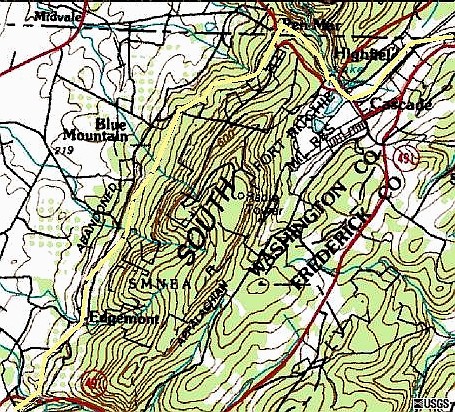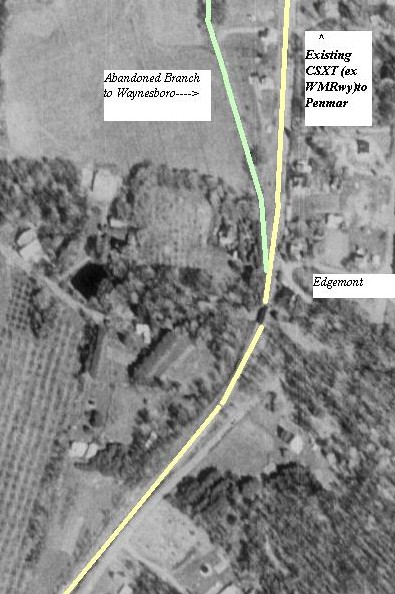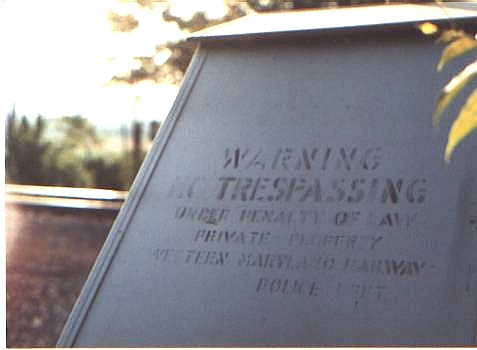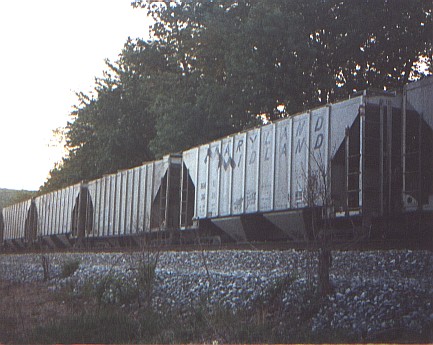Cavetown to Highfield May 2001

The Eastern Slope of South Mountain-The Blue Ridge in Maryland and Pennsylvania










>

>

>

>

>

>

 ?
?



Hotels along the WM early 1900's
ICC Accident Reports
January 11, 1913.
In re investigation of accidence on the Western Maryland Railway at Blue Mountain, Md., November 27, 1912.
On November 87, 1912, there was a head-end collision between two freight trains on the Western Maryland Railway at Blue Mountain siding about 15 miles east of Hagerstown, Md., resulting in the death of a employees and the injury or 3 employees.
After investigation I beg to submit the following report:
At the point where the accident occurred the Western Maryland Hallway is a single track line running east and west. There is a 6-degree curve, about 2000 feet long, loading toward the north, and a 11/4 per cent grade ascending toward the east. From a train rounding this curve the view of the track ahead is obstructed by a hill and by trees, and is limited to but a few hundred fact. Blue Mountain aiding is on the south side of the main track and is about 2000 feet long. The block system is not used on this road; trains are operated by time table rules and train orders, east-bound trains being superior by direction. About 30 trains are operated over this road daily.
On November 26 and 27 east-bound freight train No. 204 left Hagerstown Md., in four sections, the first three of which carried green classification signals indicating that one or more sections were following. First No. 24 departed at 9:40 p.m., November 26; second No. 204 departed at 10:32 p.m., November 26th; third No. 204 departed at 18.53 a.m., November 27th. Conductor Nichols and Engineman Henrickson were in charge of fourth No. 204, which consisted of 2 engines and 27 cars.
Highfield is a junction point about 17 miles from Hagerstown. There is train register is maintained, in which a record is kept of the time of arrival and departure of trains, signals displayed, and signatures of conductors and names of Enginemen. Superintendent Berry of this division testified that it was the duty of conductors to check train registers and that Enginemen are not required to so or to sign
them. First No. 804 arrived in Highfield at 2:17 a.m., and departed as No. 218 at 2:35 a.m., bound for York, Pa. Second No. 204, with Conductor Mentor and Engineman Brown in charge, arrived at Highfield at 2:19 a.m. Upon arrival, Conductor Mentor went to the office and registered is train, the entry indicating that his train had run from Hagerstown to Highfield an second No. 204, carrying green signals. As the conductor was occupied by other duties, the operator registered the time of departure of this train, the entry indicating that this train left Highfield at 2:26 as No. 204, carrying no signals. This train left over the main line, bound for Baltimore.
Fourth No. 804 overtook third 804 at will switch, about 4 miles east of Hagerstown, As fourth No. 804 had an order giving I time on second and third section of west-bound passenger train No. 7 to Chewsville the signing's of these two section were exchanged as provided by rule 94, and this train proceeded to Chewsville, Train orders were there received directing this section to run as third No. 804. As 8:55 a.m. this section departed from Edgemont, which was the last open telegraph station passed by this train before the accident occurred.
West-bound freight rain first No. 808 departed from Baltimore at 8 p.m., November 26, bound for Hagerstown, and at the time of the accident consisted of an engine and 19 cars. Conductor King and Engineman Eckhardt were in charge of his train, First No. 203 arrived at Mighfield at 3:19 a.m., November 27, Conductor King stated that upon arrival at Highfield he went to the office, registered his train, and examined the register, He stated that no signals, and that he repeated this to the operator in the presence of his head brakeman. After receiving a 19 order calling attention to a switch was out of service, and a eleargnoegard, he left the office, climbed upon the engine and told Engineman Eackhardt that the schedule or No. 204 east was filled. First No. 203 left Highfield at 8:23 a.m. and collided with third No. 204 at Blue Mountain siding at 3:30 a.m. At the time of the Collision the speed of first No. 203 was estimated a about 20 miles per hours. At the time of accident the weather was clear.
The register book maintained at Highfield is of the form commonly used on railroads and was property kept, In this register book he record of the arrival of second No. 204 at 2:19 a.m., carrying green signals from Hagerstown to Highfield, was entered on the third line; the departure of this trains was noted on the fourth line, the entry reading train no. 204, signals name, departing 2:28 a.m.
Operator Harbough was on duty at Highfield stated that conductor King come to the office, registered his train, checked the register and asked the operator if there were any orders. The operator gave his a nineteen order and a clearance card. He stated that be did not have any conversation with Conductor King regarding the other sections of No. 204 and that he did not hear Conductor King speak of the train register at all. When first No. 203 departed he supposed a meeting point farther along he line had been fixed.
Head Brakeman Spiegel of first No. 205 stated that at Highfield the conductor went in and registered. He came out with a nineteen order, and said that first and second No. 804 had filled their schedule and second No. 24 carried no signals
As a result of this investigation it is believed that conductor king of first No. 203 in checking over the register at Highfield noted the entry on the fourth line regarding the departure of No. 204 instead of the entry on the third line nothing the arrival of second No. 204 carrying green signals indicating a following section. The error on the part of conductor king in checking the train register was the cause of this accident.
Conductor King had been in the employ of this company for ten years, and had been employed as a conductor for six years. his record was good and he was regarded as a careful and competent man. At the time when the accident occurred he had been on duty 71/2 hours, after a period off duty of 15 hours. None of the employees involved in this accident was on duty contrary to any of the provisions of the hours of service law.
While this accident was due directly to the failure of an employee properly to perform his duty, it was rendered possible by the system of train operation employed, and displays the inherent weakness of this method of train operation, Had an adequate block signal system been in operation on the Western Maryland. Railway at this place the accident probably would have been averted. Under the block system fewer opportunities or errors likely to lead to disinter are presented, and it is believed that the volume of traffic over this road is large enough to warrant the installation of this road is large enough to warrant the installation of the block system.
In re Investigation of Accident on the Western Maryland Railroad at Pen Mar, Pa., December 6, 1912.
On December 6, 1912, there was head-end collision between a freight train and a train consisting of empty passenger cars on the Western Maryland Railway at Pen Mar, Pa., resulting in the death of four employees and one trespasser and the injury of six employees and two trespassers. After Investigation, I beg to submit the following report:
At the place where the accident occurred the Western Maryland Railway is a single-track road running east and west. No block system is in use; trains are operated under the timetable and train order system, east-bound trains being superior by direction; trains following one another are spaced 10 minutes apart at open telegraph offices.
Approaching the point where the collision occurred from the went there is a tent about 1060 feet in length, followed by a 7 degree curve leading toward the south. On this curve there is an ascending grade of 1.46 per cent for east-bound trains and the track passes through a out 20 feet deep which obstructs the view In both directions, The collision occurred in thin out, about 500 feet from the wont end of the curve. On the date of the accident west-bound freight extra 757 left Baltimore at about 1:100 p.m. at the time of $110 accident this train consisted of engine 767, 11 loaded and 25 empty cars, and helper engine 610, which was coupled In behind the fourth ear from the head end, Conductor Eyehole-berger and Engineman Helbig were In charge of this trains ,which arrived at Highfield at 10:52 p.m. There order No. 116 was received, reading as follows:
Engine 757 will run extra Highfield to Hagerstown. Extra 707 west will 1st No. 204 at Blue Mountain and has right over 4th No. 204 and No. 322 Highfield to Cheweville. Extra 757 left Highfield at 11:31 p.m., and collided with 1st 204 at a point 1.6 miles west of Highfield at about 11:43 p.m. Employees in charge of this train stated that at the time of the collision the speed of this train was 18 or 20 miles per hour.
Conductor Butts and Engineman Staub were in charge of freight train 1st No. 204 when it left Hagerstown on the Might of the accident. After doing some work at Edgemont, this train went in on the passing siding to meet west-bound passenger train No. 7. The train order signal was in the stop position, and Conductor Butte went to the telegraph office where he was given train Order No. 118, quested above, which was addressed to the conductor and Engineman of 1st No. 204. This order was made complete at 10:57 p.m. He was also given a '19' order, No. 119, addressed to 1st, 2nd and 3rd No. 204, at Edgemont, the order reading;
3rd No. 204, engine 157, will pass 1st and 2nd No. 204 at Edgemont and change numbers accordingly.
This order was made complete at 11:00 p.m., 3 minutes after order 118 was completed, and Conductor Butts received these orders at the same time. Order No. 119 made his train 2nd No. east of Edgemont; Conductor Butts accepted both orders without comment and left the office. He gave one copy of each order to his brakeman to deliver to Engineman Staub and than went to the Caboose.
East-bound train 3rd 204, consisting of engine No. 157, a combination baggage and mail car and two coaches, with Conductor Fauver and Engineman Cook in charge, left Hagerstown at 10:25 p.m., for Highfield. At Hagerstown Conductor Fauver received order No. 115, reading as follows:
Engines 325 and 157 will display signals and run as 2nd and 3rd No. 204, Hagerstown to Highfield. When this train arrived at Edgemont at 11:05 p.m., the train order board was in the Stop position and Conductor Fauve went into the telegraph office where he was given a copy of order No. 110, directing his train to pass the 1st and 2nd sections.
At this time 1st and 2nd No. 204 were on Edgemont passing siding to meet west-bound passenger train No. 7. The west switch of this siding is just that of the telegraph station. To meet No. 7 3rd No. 204 pulled in on the storage track which is a short siding opposite the passing siding, the main track running between the storage and the passing siding.
Conductor Fauver delivered copies of order No. 119 to Engineman Cook and *** Stom of his train, and then under an arrangement made among the crew of this train, without the knowledge or consent of officers of the company, he and Fireman Fearl Left this train and returned to Hagerstown on No. 7, leaving the train in charge of Engineman Cook, Baggamaster Loiter and Flagman Stem who was qualified conductor. After No. 7 passed, this train, which by order No. 119 was then 1st 204, left Edgemont at 11:30 p.m. and proceeded about 407 miles. While running at a speed of approximately 25 miles per hour it collided with extra 757, west, at a point about 500 feet east of Pen Mar station.
Dispatcher Weigh who issued the orders in question stated that while had had order No. 119 in mind when he completed order No. 118, he did not issue order No. 118 to 3rd No. 204 as he expected Conductors Fauver and Butts to exchange orders. He also stated that he told Operator Smith to be sure that Fauver got order 118 from Butts; he did not receive any response from Smith, however, and Operator Smith stated that he did not receive any south instructions from the dispatcher.
Conductor Butts and Engineman Staub stated that as order No. 119 was received and became effective at an open telegraph station they considered it the dispatcher's duty to provide the passing train with order No. 118. Both, however, stated delivered order No. 118 to this train before allowing it to pass. Conductor Fauver stated that he did not inquire of the crews job the trains which order no. 19 gave him the right to pass whether or not they held orders which would affect his train, for the reason that the rules did not require it. He stated that had the passing point been at a non-telegraph station he would have exchanged orders with the crew of the train which he passed.
A proper regard for the safe movement of their trains would have required the crews involved to confer concerning this movement, for the purpose of ascertaining whether or not any orders were hold by them which would affect their trains after the rearrangement of sections had been made, even though the rules did not require them to do so.
Rule No. 94 of the Western Maryland Railroad reads as follows:
94, A train which overtakes a superior train or a train of the same class, so disabled that it cannot proceed will pass it, if practicable, and if necessary will assume them schedule and take the train orders of the disabled train, proceed to the next open telegraph office, and there report to the Train Master, The disabled train will assume the schedule and take the train orders of the last train with which it has exchanged, and will when able proceed to and report from the next open telegraph office.
The statements of employees indicate that under this rule it was customary, when a train passed a superior train, or one section passed another section of the same train, at a non-telegraph station, for the crews to confer regarding the movement and the exchange of signals and orders. By in-ference this rule covers conditions arising only at non-telegraph stations. The statements of all the employees questioned regarding the practice in making a movement of this kind by train order at an open telegraph station indicate that they did not consider it incumbent upon them to exchange orders, but depended upon the dispatcher to provide each of the trains involved with copies of all orders affecting them. The movement in question being made at an open telegraph station by direction of the train dispatcher, they believed it his duty to make provision for supplying all the train affected with orders which would insure their safe movement from that place.
This accident was caused by failure of Dispatcher Fleigh when he issued order No. 119 to make definite arrangements for providing the train which by that order became 1st No. 204 with order No. 110 which vitally affected it. The rules governing the operation of trains and the forms of orders used on the Western Maryland Railroad are printed in the timetable and designated as "standard code". Had Dispatcher Fleigh handled the movement in accordance with the forms prescribed by these rules, it would have been necessary to annul the three trains as sections of 204 and issue a new order rearranging the sections. This would have necessitated the reissue of order No. 118 which would have been signed by first No. 204 leaving Edgemont, thus insuring its delivery to the train that was to execute it.
None of the employee involved in this accident was on duty contrary to and or the provisions of the hours of service law. Dispatcher Fleigh had been employed by this company as an operator for two years, and as a dispatcher for five years. Conductor Fauver had been employed by this company as a brakeman for three years and as conductor for 19 years. His record chows that during the past 7 years he had received 85 demerit marks and had been suspended 39 days. Engineman Cook had been employed by this company 30 years; he had been an Engineman for 27 years. Conductor Butts had been employed six years, two years of which were as conductor. Engineman staub had been in the employ of the company six years, about 8 months of which had been as Engineman.
While this accident was due directly to the failure of an employee properly to perform his duty, it was rendered possible inherent weakness of such a system. A large proportion of the accidents which have been investigated has been due to mistakes which have occurred under the train order method of train operation. Under the block system fewer opportunities for errors likely to land to dissenter are presented, and it is believed that the volume of traffic over this road is large enough to warrant the installation of the block system.
Back to World's Great Railroads Index Page
Back to Cathell's MountainHome Page